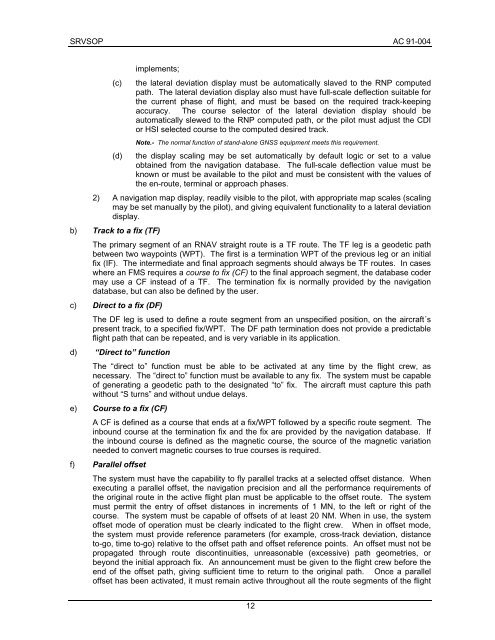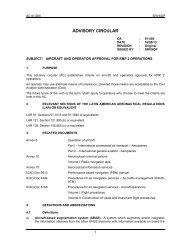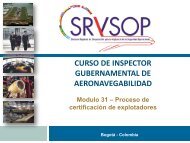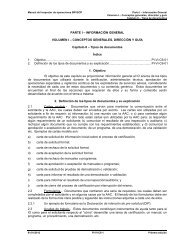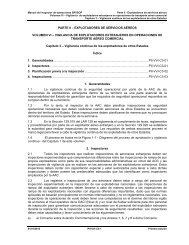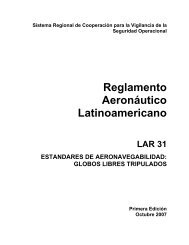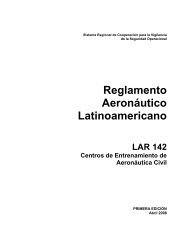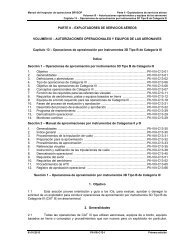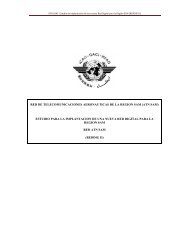ac 91-004 srvsop - ICAO
ac 91-004 srvsop - ICAO
ac 91-004 srvsop - ICAO
You also want an ePaper? Increase the reach of your titles
YUMPU automatically turns print PDFs into web optimized ePapers that Google loves.
SRVSOP AC <strong>91</strong>-<strong>004</strong><br />
(c)<br />
implements;<br />
the lateral deviation display must be automatically slaved to the RNP computed<br />
path. The lateral deviation display also must have full-scale deflection suitable for<br />
the current phase of flight, and must be based on the required tr<strong>ac</strong>k-keeping<br />
<strong>ac</strong>cur<strong>ac</strong>y. The course selector of the lateral deviation display should be<br />
automatically slewed to the RNP computed path, or the pilot must adjust the CDI<br />
or HSI selected course to the computed desired tr<strong>ac</strong>k.<br />
Note.- The normal function of stand-alone GNSS equipment meets this requirement.<br />
(d) the display scaling may be set automatically by default logic or set to a value<br />
obtained from the navigation database. The full-scale deflection value must be<br />
known or must be available to the pilot and must be consistent with the values of<br />
the en-route, terminal or appro<strong>ac</strong>h phases.<br />
2) A navigation map display, readily visible to the pilot, with appropriate map scales (scaling<br />
may be set manually by the pilot), and giving equivalent functionality to a lateral deviation<br />
display.<br />
b) Tr<strong>ac</strong>k to a fix (TF)<br />
The primary segment of an RNAV straight route is a TF route. The TF leg is a geodetic path<br />
between two waypoints (WPT). The first is a termination WPT of the previous leg or an initial<br />
fix (IF). The intermediate and final appro<strong>ac</strong>h segments should always be TF routes. In cases<br />
where an FMS requires a course to fix (CF) to the final appro<strong>ac</strong>h segment, the database coder<br />
may use a CF instead of a TF. The termination fix is normally provided by the navigation<br />
database, but can also be defined by the user.<br />
c) Direct to a fix (DF)<br />
The DF leg is used to define a route segment from an unspecified position, on the aircraft´s<br />
present tr<strong>ac</strong>k, to a specified fix/WPT. The DF path termination does not provide a predictable<br />
flight path that can be repeated, and is very variable in its application.<br />
d) “Direct to” function<br />
The “direct to” function must be able to be <strong>ac</strong>tivated at any time by the flight crew, as<br />
necessary. The “direct to” function must be available to any fix. The system must be capable<br />
of generating a geodetic path to the designated “to” fix. The aircraft must capture this path<br />
without “S turns” and without undue delays.<br />
e) Course to a fix (CF)<br />
A CF is defined as a course that ends at a fix/WPT followed by a specific route segment. The<br />
inbound course at the termination fix and the fix are provided by the navigation database. If<br />
the inbound course is defined as the magnetic course, the source of the magnetic variation<br />
needed to convert magnetic courses to true courses is required.<br />
f) Parallel offset<br />
The system must have the capability to fly parallel tr<strong>ac</strong>ks at a selected offset distance. When<br />
executing a parallel offset, the navigation precision and all the performance requirements of<br />
the original route in the <strong>ac</strong>tive flight plan must be applicable to the offset route. The system<br />
must permit the entry of offset distances in increments of 1 MN, to the left or right of the<br />
course. The system must be capable of offsets of at least 20 NM. When in use, the system<br />
offset mode of operation must be clearly indicated to the flight crew. When in offset mode,<br />
the system must provide reference parameters (for example, cross-tr<strong>ac</strong>k deviation, distance<br />
to-go, time to-go) relative to the offset path and offset reference points. An offset must not be<br />
propagated through route discontinuities, unreasonable (excessive) path geometries, or<br />
beyond the initial appro<strong>ac</strong>h fix. An announcement must be given to the flight crew before the<br />
end of the offset path, giving sufficient time to return to the original path. Once a parallel<br />
offset has been <strong>ac</strong>tivated, it must remain <strong>ac</strong>tive throughout all the route segments of the flight<br />
12


